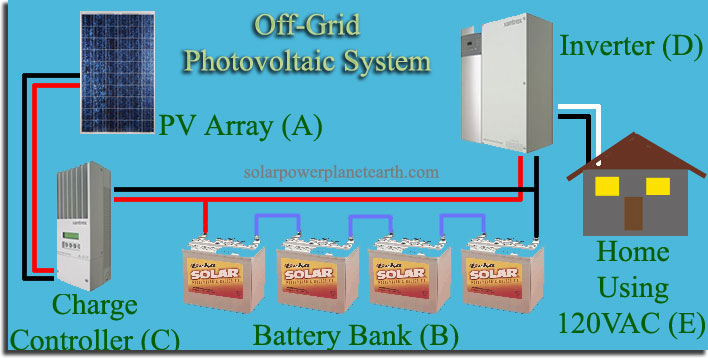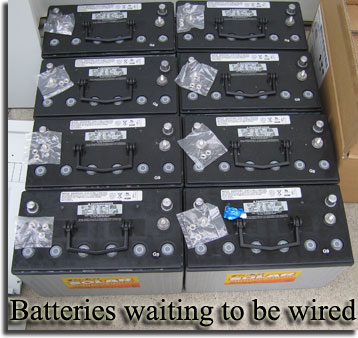 |
Off-Grid Solar Power Systems
The most common type of solar power system used is a grid-tied solar system; however, owners of residential and small scale commercial structures which are located in remote areas and do not have utility power, typically only have two choices in regards to power. You can either pay the utility to run transmission lines to your home, which can be rediculously expensive, or install your own power source, such as an off-grid solar system. An off-grid solar system utilizes an array of deep-cycle batteries to store the power generated by your solar panels. The batteries are connected to an inverter, similar to the one you would use for a grid-tied solar system, which then converts the battery bank voltage to 120VAC that is then used by all your standard appliances and lighting. The layout is slightly different than a grid-tied solar system, and is shown in the graphic below.

(A) Properly Sized Solar Array
The array of solar panels convert sunlight into direct current electricity through the photovoltaic effect. Your solar array must be sized large enough to enable fully charging the batteries for overnight use, as well as suppling power during the day. The array must be slightly oversized to account for a seasonal average number of cloudy days.
(B) Battery Bank
Your solar array only provides power during the day, and the amount can vary depending on the weather, the season, and time of day. Because of this, you need a battery bank to not only store power for use during times of bad weather or no sun, but to provide a stable power source. There are many different types of batteries, which can be read about on our solar batteries page. The one thing all solar system batteries have in common, is that they are "deep-cycle" batteries. This means they can go from being fully charged to fully discharged many number of times, in contrast to say a car battery, which would no longer hold a charge after a small number of times of fully discharging it (i.e. leaving your lights on until the battery is dead).
Batteries come in many different voltages, any where from  2V per battery to 12V per battery. Batteries also come with different capacities, which are measured in "Amp-Hours (Ah)". No matter which voltage level or capacities the batteries come in, they are put into banks, where the batteries are placed in series-parallel combinations, so that their voltages add up to a nominal amount. So for example, if we were using 12v 100Ah batteries, and we wanted to create a common 48V battery bank, with a 400Ah capacity, we would need to have four series strings of four batteries, in parallel. What? Let's break it down to make it easier to understand. By putting four 12V batteries in series, we add the voltages, but get no capacity increase. In other words, we would get 48V at 100Ah, which is shown in the diagram above. So now if we want to increase this to 400Ah, we need 3 more of these strings, and then place all four of these strings in parallel. When you place them in parallel the capacities add and the voltages do not. See our electricity 101 tututorial for a more detailed explanation on battery configurations, voltages, and capacities.
2V per battery to 12V per battery. Batteries also come with different capacities, which are measured in "Amp-Hours (Ah)". No matter which voltage level or capacities the batteries come in, they are put into banks, where the batteries are placed in series-parallel combinations, so that their voltages add up to a nominal amount. So for example, if we were using 12v 100Ah batteries, and we wanted to create a common 48V battery bank, with a 400Ah capacity, we would need to have four series strings of four batteries, in parallel. What? Let's break it down to make it easier to understand. By putting four 12V batteries in series, we add the voltages, but get no capacity increase. In other words, we would get 48V at 100Ah, which is shown in the diagram above. So now if we want to increase this to 400Ah, we need 3 more of these strings, and then place all four of these strings in parallel. When you place them in parallel the capacities add and the voltages do not. See our electricity 101 tututorial for a more detailed explanation on battery configurations, voltages, and capacities.
Higher voltage battery strings are more ideal to minimize power loss through resistive heating of the wiring. 48V battery banks are fairly standard. See our electricity 101 tutorial for a more advanced understanding how efficiency is lost at lower voltages.
(C) Charge Controllers
Due to the physical properties of deep-cycle batteries, it matters how the batteries are charged. Proper charging/discharging of the batteries will maximize the battery's life. This is accomplished this through the use of a solar charge controller. The charge controller not only regulates the charging of the batteries, but also allows for a higher voltage solar array to charge a lower voltage battery bank. As an example, lets say we have the 48VDC battery bank used above, but we have a 1000 Watt (1 kW) solar array that puts out 5 Amps (A) at 200VDC (5A*200V = 1000 Watts). We could not hook the solar array directly into the batteries because of the difference in voltage. So what the charge controller does is "step down" the voltage from the solar array to the appropriate charge voltage for the batteries, which turns out to be close to the battery bank voltage.
Do we loose power since we are reducing the voltage coming from the solar array? No. The power out of the charge controller is equal (minus charge controller efficiency losses) to the power coming in from the solar array. If you have read our electricity 101 tutorial, you will remember that power is equal to voltage x current. So that means when the charge controller reduces the array voltage, it raises the current. Continuing the example above, if we were to take the 5A 200VDC (1000 Watts) array output down to 50V at the output of the charge controller, the charge controller would increase the current from 5A to 20A at it's output, since 20A x 50V equals 1000W. In other words, 1000W in, 1000W out, just at different voltages. Make sense? If not, read our electricity 101 tutorial.
Most charge controllers also use a technique known as Maximum Power Point Tracking (MPPT), which constantly adjusts the voltage/current ratios coming from the solar panels to obtain
(D) Solar Inverter
The inverter in an off-grid system is "inverting" the direct current (DC) voltage from the battery bank to alternating current (AC) for use with your standard appliances and lighting. Once again using the examples mentioned above, if we have our 48VDC battery bank, and we need 120VAC for our appliances and lighting, the inverter makes this transition for us.
(E) Home Using 120VAC
Your home now has 100% self-contained clean solar power!